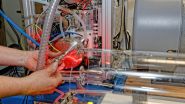(Press-News.org) Sperm in the first fraction of ejaculate are more numerous, move more and present better quality DNA than those lagging behind. This is the conclusion of a study led by the Ginemed fertility clinic, which confirms that while the objective of the first fraction is to fertilise the egg, the second phase is so that no sperm from any other male has a chance to fertilise it.
A study led by the Ginemed Assisted Human Reproduction Clinic analyses the advantages of using fractions of ejaculate separately in in-vitro fertilisation as a way to improve the sample of the semen.
The researchers' hypothesis was that, comparing the different fractions of semen in an ejaculation, the first would contain sperm with better seminal parameters and could be used as an effective method for selecting sperm prior to fertilisation.
"Ejaculate has always been considered as a whole. However, we believe that it is divided into two quite different phases due to its composition and physiological functions, aimed at achieving two equally important actions in terms of reproduction," María Hebles, co-director of the reproduction laboratory at the Ginemed Clinic in Seville and lead author of the study, explains to SINC.
The first objective of ejaculate would be to fertilise the egg and the second so that no other male has the opportunity to fertilise it. Therefore, the first fraction is characterised as having protective components such as zinc, whereas the second contains elements that can cause damage to sperm.
However, for their use in assisted reproduction techniques, the liquid is normally collected in a single container, and therefore both phases are mixed together. This could have a detrimental effect on the sperm population," adds Hebles.
Based on this, the specialists asked 40 participants to collect the ejaculate separately into two containers, one for each phase. They then separated the first and the second phase and studied the characteristics of the sperm in each of them.
Data suggests that the first phase contains an enhanced subpopulation of sperm, with less sperm DNA fragmentation. Therefore, the use of sperm from this fraction can have a positive effect on fertilisation and embryonic development.
"As we were expecting, the sperm from the first fraction of ejaculate were faster moving and the count was higher, and more importantly, they had higher DNA integrity than sperm from the second phase," says the researcher.
In light of the results, the experts now have a protocol requesting all patients to collect the ejaculate in two fractions, "improving the quality of the sperm used for fertilisation simply and at no cost at all," Hebles adds.
Ejaculation phases
The fluid expressed during ejaculation is composed of various fragments, shared between a pre-ejaculation phase and the first and the second fraction of the ejaculate. Although there are no definitive studies to this regard, the pre-ejaculatory phase or pre-seminal fluid does not contain sperm; it is a colourless secretion from the Cowper's glands which is expelled to lower the acidity of the urethra.
On the other hand, the first fraction represents between 15 and 45% of ejaculate volume, is rich in sperm, acid phosphatase, citric acid, magnesium and zinc, which effectively protect the sperm. The second fraction consists of the remaining volume, between 70 and 90% and is composed of secretions from the seminal vesicles rich in reactive oxygen species which have a negative effect on the seminal characteristics.
INFORMATION:
Reference:
María Hebles, Mónica Dorado, Miguel Gallardo, Mercedes González-Martínez, Pacual Sánchez-Martín. 'Seminal quality in the first fraction of ejaculate'. Syst Biol Reprod Med, Early Online: 1-4 2014 DOI: 10.3109/19396368.2014.999390
Contact:
María Hebles Duvison
Clínica Ginemed de Sevilla
Tel: 95 499 11 93
Email: MHebles@ginemed.es
Strapped into a motion-enabled simulator and wearing 3D glasses, 36 adolescent volunteers recently experienced what it was like to "travel" through a field of virtual stars. The experiments provided new and convention-busting data about how sensory stimuli are processed by the brains of individuals with Autism Spectrum Disorder.
The study, entitled "Self-motion perception in autism is compromised by visual noise but integrated optimally across multiple senses," was published online in the Proceedings of the National Academy of Sciences on May 4th, 2015. The authors of ...
The team has completed two genomics studies on the tropical disease, a condition that is estimated to cause up to 30 million illnesses and over a quarter of a million deaths globally each year.
The first study, published in the journal Nature Genetics, suggests that the H58-strain, which is likely to have emerged in Asia approximately thirty years ago, is now rapidly spreading across Africa, where it has been introduced on several separate occasions. A key feature of this strain appears to be its ability to acquire resistance to commonly available antibiotics.
Dr Melita ...
TORONTO, May 27, 2015--A good working relationship with police is essential for the smooth operation of a busy Emergency Department. Police are in and out of EDs regularly, supporting EMS, transporting patients and helping to provide a safe environment for hospital staff.
Not surprisingly, differences of opinion arise from time to time over a health care worker's duty to protect patient privacy and the police need to conduct a criminal investigation.
That's why it's essential to develop strategies to optimize communications between police and ED workers, according to ...
ATHENS, GA - Over the past century, many forests have shifted from open to closed canopies. The change in forest structure could be contributing to declines in pollinator species, especially native bees, according to a new study by U.S. Forest Service scientists.
The study shows how common present-day forest conditions affect pollinators, especially bees. "Bees prefer open forests," says Jim Hanula, a research entomologist at the Southern Research Station (SRS) Insects, Diseases, and Invasive Plants research unit. "We found that total tree basal area was the best predictor ...
WASHINGTON, May 26, 2015 -- You might have heard that microwaving your food is dangerous. Maybe your health nut friend told you that eating frozen veggies is less healthful than eating fresh ones. Is a glass of red wine really good for your heart? This week, Reactions is here to sort out the "old wives' tales" from the facts, taking on a swath of food myths. Check out the videos here: http://bit.ly/ACSFoodMyths.
Subscribe to the series at http://bit.ly/ACSReactions, and follow us on Twitter @ACSreactions to be the first to see our latest videos.
INFORMATION:
The ...
CLEMSON, S.C. -- If you've been to the doctor, you probably know what to do when you're handed a plastic cup and shown to the bathroom.
Most patients hand over the sample and give little thought to what happens when it's shipped to the lab for analysis.
Ken Marcus and his students are the exceptions. They have developed a new testing method that they believe will reduce costs, get faster results and lower the volume of urine needed for a sample.
Marissa Pierson, a master's student, closes the lid on a centrifuge while working in a Clemson University lab with Ken Marcus.
It's ...
This news release is available in German.
Quantum physics is full of fascinating phenomena. Take, for instance, the cat from the famous thought experiment by the physicist Erwin Schrodinger. The cat can be dead and alive at once, since its life depends on the quantum mechanically determined state of a radioactively decaying atom which, in turn, releases toxic gas into the cat's cage. As long as one hasn't measured the state of the atom, one knows nothing about the poor cat's health either - atom and kitty are intimately "entangled" with each other.
Equally striking, ...
This news release is available in German.
Leipzig / Helsinki. A first global scale study has estimated how forest emitted compounds affecting cloud seeds via formation of low-volatility vapours. According to the latest projections, terrestrial vegetation emits several million tons of extremely low-volatility organic compounds (ELVOCs) per year to the atmosphere. These oxidation products of compounds such as monoterpenes results in an increase of condensing vapours that can further form cloud condensation nuclei over the continents and thus has an influence ...
Montréal, May 25, 2015 - A team of researchers at the IRCM led by François Robert, PhD, uncovered a critical role for two proteins in chromatin structure. Their breakthrough, recently published in the scientific journal Molecular Cell, helps explain how DNA is organized in our cells. This discovery could lead to a better understanding of what causes certain types of cancer, such as lymphoma.
Dr. Robert and his team study chromatin, the structure composed of DNA and proteins that makes up chromosomes. Its main role is to package DNA molecules containing all the ...
LOS ANGELES (May 26, 2015) - Biomedical researchers at Cedars-Sinai have invented a tiny drug-delivery system that can identify cancer cell types in the brain through "virtual biopsies" and then attack the molecular structure of the disease.
If laboratory research with mice is borne out in human studies, the results could be used to deliver nano-scale drugs that can distinguish and fight tumor cells in the brain without resorting to surgery.
"Our nanodrug can be engineered to carry a variety of drugs, proteins and genetic materials to attack tumors on several fronts ...


